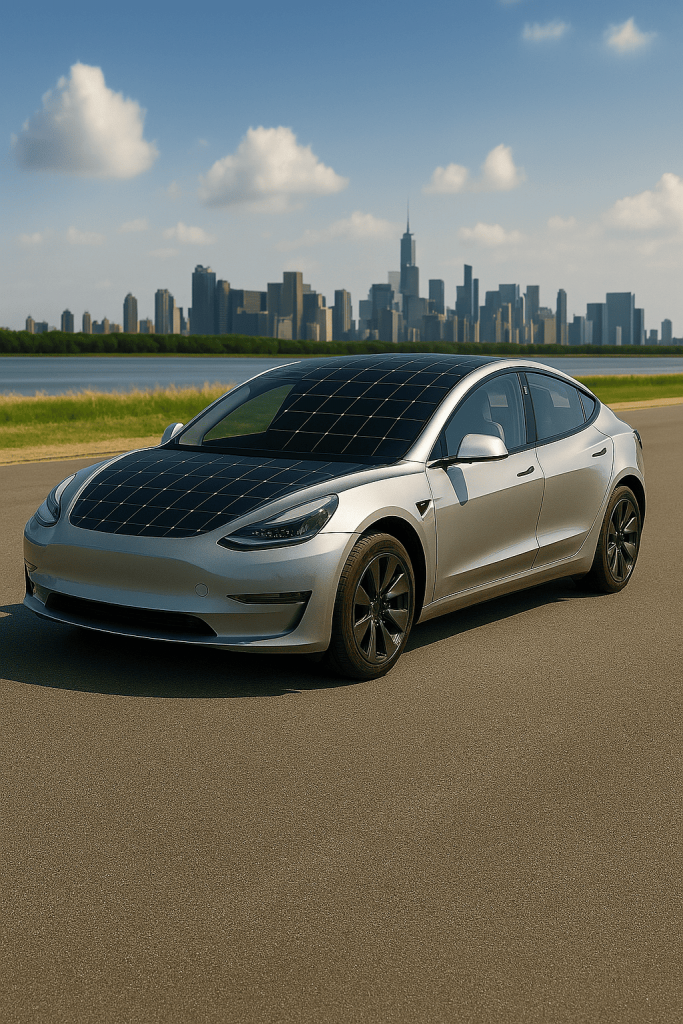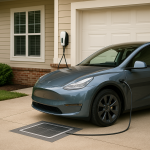As the automotive industry evolves toward cleaner and more sustainable technologies, integrating solar panels directly into electric vehicles (EVs) emerges as one of the most promising and compelling innovations. The concept of a car partially powered by sunlight has intrigued both consumers and industry experts for decades. But despite early enthusiasm, solar-powered EVs have yet to become mainstream. So, how close are we to seeing solar-powered electric cars in mass production? This article examines the state of solar EV technology, evaluates the current challenges and limitations, reviews ongoing developments by industry leaders, and assesses when widespread adoption may occur.
Understanding Solar-Powered EV Technology
Solar panels integrated into electric vehicles typically use photovoltaic (PV) cells installed on the car’s roof, hood, or trunk. These panels convert sunlight into electrical energy, either directly charging the vehicle’s battery or powering auxiliary systems. While vehicle surface areas restrict the total number of solar cells that can be effectively installed, even modest power generation can positively impact vehicle range, energy efficiency, and overall autonomy.
Advantages of Solar Integration in Electric Vehicles
Solar panel integration offers multiple benefits:
– Extended Driving Range: Under optimal sunny conditions, integrated solar panels could potentially add 10 to 50 kilometers per day, significantly enhancing short-distance commuting and reducing the frequency of grid charging.
– Reduced Grid Dependency: By generating electricity directly from sunlight, solar-powered EVs lower reliance on grid-sourced electricity, thus reducing the overall carbon footprint—particularly valuable in areas still heavily dependent on fossil fuels.
– Improved Battery Health: Constant trickle-charging from solar energy helps maintain battery health, potentially extending its lifespan and reducing degradation caused by deep discharging cycles.
– Energy for Auxiliary Systems: Solar panels can independently power in-car electronics such as climate control, infotainment, and vehicle diagnostics, thereby preserving the primary battery’s energy for driving.
Current Technical and Economic Limitations
While appealing, solar-powered vehicles currently face substantial challenges that limit mass adoption:
– Limited Surface Area: The available space for solar panels on a car is constrained, restricting potential energy generation. Current technology allows only incremental improvements in daily range.
– Panel Efficiency: Standard commercial photovoltaic cells have efficiencies between 20%–25%. Higher efficiency cells, while available, significantly raise production costs.
– Environmental Factors: Solar energy production can drastically fluctuate based on geographical location, seasonal variations, weather conditions, and shading from buildings or trees.
– Cost and Complexity: Integrating high-quality solar panels into vehicle design increases production complexity and manufacturing costs. Manufacturers must balance cost efficiency with consumer affordability.
Leading Companies and Real-World Applications
Despite these challenges, several companies are actively pushing the envelope with innovative solar EV solutions:
– Lightyear (Netherlands): The flagship Lightyear 0, launched in limited quantities, claims up to 70 kilometers of additional solar-powered range per day. The company aims to release a more affordable model, the Lightyear 2, targeted at wider market adoption by 2025.
– Aptera Motors (USA): California-based Aptera developed a highly aerodynamic, three-wheeled EV boasting an impressive total range exceeding 1,000 kilometers, with solar charging capabilities adding up to 65 kilometers daily under ideal conditions. Its innovative, ultra-lightweight design pushes the boundaries of energy efficiency.
– Sono Motors (Germany): With the Sion, Sono Motors introduced a solar-powered compact EV integrated with solar cells covering most of its exterior surface, generating approximately 112–245 kilometers of additional weekly range, ideal for urban commuting.
– Established Automakers: Hyundai and Toyota offer optional solar roofs in select hybrid models, such as the Sonata Hybrid and Prius Prime. While their solar technology currently provides limited range extension, these early applications demonstrate significant industry interest and potential future expansion.
Advances in Solar Technology and Future Opportunities
Significant research is underway to enhance photovoltaic cell efficiencies and reduce costs. Emerging technologies, including perovskite solar cells and flexible thin-film panels, promise substantially improved performance and integration capabilities in vehicle surfaces. Additionally, innovations like transparent solar cells could allow integration into car windows and panoramic roofs, further expanding available surface areas for energy generation.
Market Projections and Industry Trends
Industry analysts, including IDTechEx, forecast significant market growth for solar-equipped EVs, predicting a global market value exceeding $3 billion by 2031. Declining solar cell costs, increased consumer interest in sustainability, and supportive government policies will likely accelerate adoption.
Notably, governmental incentives in regions like Europe, North America, and parts of Asia could significantly stimulate growth. Policies designed to encourage renewable energy integration in transportation could prove crucial for broader industry acceptance.
When to Expect Mass Production
Mass production of solar-integrated EVs is currently in the nascent stages, with limited-scale production already underway through niche manufacturers like Lightyear and Aptera. Broad-scale adoption by major automakers, however, is realistically projected within the next five to ten years, contingent on continued technological advancement and manufacturing cost reductions.
Industry experts anticipate initial mass-market adoption will focus primarily on auxiliary energy generation and incremental range improvements rather than fully solar-powered driving. As technology advances, mass-market affordability increases, and infrastructure expands, solar panel integration could become commonplace on mainstream electric vehicles, particularly in urban commuter and fleet markets.
Conclusion
Integrating solar panels into electric vehicles represents a significant step toward more sustainable transportation, promising increased autonomy, reduced environmental impact, and improved efficiency. While challenges like limited surface area, cost, and efficiency currently restrain widespread implementation, ongoing advancements and substantial investment suggest a bright future.
The path to mass production is likely to unfold gradually, with initial steps focusing on supplementary power generation rather than total solar dependence. As technology matures and economies of scale take effect, solar-powered EVs could evolve from niche innovation into standard automotive features. For consumers, automakers, and governments committed to sustainability, the emergence of solar-integrated electric vehicles is not a matter of if, but when—and that future could arrive sooner than expected.



Looking forward to seeing how this innovation evolves in the coming years
6 mons later its not planned yet
Solar panels on EVs? Cool idea, but still low efficiency
Waiting for a breakthrough!
They’re cookin up some new types of solar panels, so is yet to come! 😁
meh, solar EVs sound cool but rly limited 😟😟
Dem ev dey aint that fancy now 😁
but they’re hella hard to recycle… 🙄
dat was a whole mess when dey seen folks was just throwin dem batteries at the landfill💀